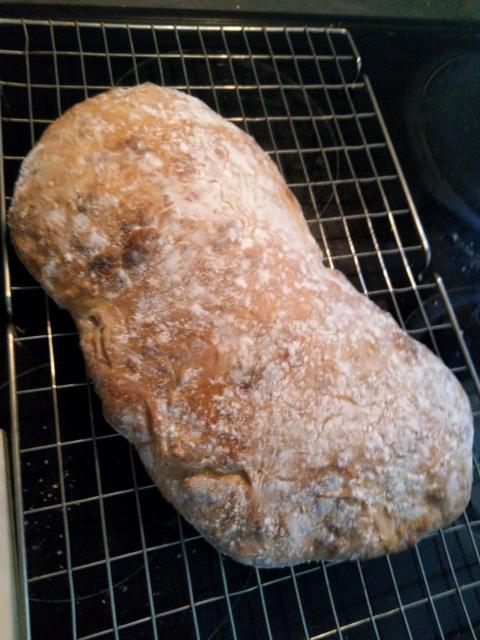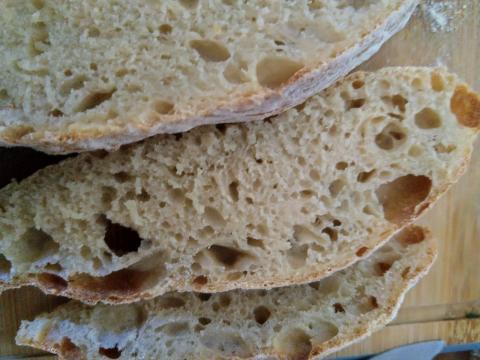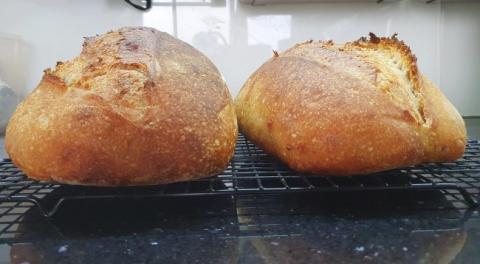
Most bookmarked

- Log in or register to post comments
- Printer-friendly version

Ankarsrum Assistent: Will it blend / mix meat?
Hi all,
I'm new here and specifically made an account for this quesfion
On these forums quite a lot of people seem to have an Ankarsrum Assistent. I'd love it's durability and design, however, I have on question.
Now my question is:
Does the machine mix minced meat? So I can make hamburgers without getting my hands dirty. (note, I mean mix, not grind/mince)
And if so, do you use the steel bowl for it, or the plastic?
Thanks!
- Log in or register to post comments
- Printer-friendly version

Dutch Oven Smoke
I have baked about 60 loaves of bread so far and the 2 dutch ovens I have been using are in desperate need of re-seasoning. As anyone had any success seasoning their cast iron dutch ovens so they don't smoke and set off the fire alarm each time you use it?
I am familiar with the different smoke points and how the general process works. If you usually use your dutch oven at 450F, pick an oil with a higher smoke point, bake for an hour at a temperature higher than the smoke point, cool, repeat for however many layers you want.
My problem is that when I bake artisan bread, I pre-heat the oven and dutch oven to 500F (about the maximum of my oven) and then drop the temp when bread is the oven. So I can't oil it with an oil with a higher smoke point and go beyond that point so it doesn't smoke when I use it at a lower temperature simply because my oven can't heat high enough. Has anyone figured out a successful way to bake with the dutch oven and not set off the smoke alarm?
- Log in or register to post comments
- Printer-friendly version

Community bake ciabatta
The community bake provided the excuse to bake a simple ciabatta recipe that a friend has been baking for years.
It is the exact opposite of my recent sourdough breads in almost every dimension: instant yeast, has no autolyse, uses sugar, is super rapid, no wholewheat, etc etc. Even for an instant recipe it is fairly minimalist eschewing the biga or couche or anything that would complicate the life of the home baker for whom the original recipe was intended.
Sometimes it is fun to try something radically different, and it reminded me of what was possible in bread baking.
The recipe then:
- 500g white bread flour (stoneground, 11.5% protein)
- 450g water (lukewarm - 28 deg C)
- 2.5g sugar (0.5 tsp)
- 4.5g instant yeast (1.5 tsp)
- 13g salt (1.5 tsp)
- 13g olive oil (1 Tbsp)
- Mixed as an all-in-one-mix; first mixed the dry ingredients (yeast, flour, sugar, salt) to ensure even distribution and then added the lukewarm water. Note: the original recipe calls for adding the salt after the dough was mixed, but went even minimalist than that with an all-in-one.
- Five minutes of stretch-and-fold (in-bowl) after mixing. More like an in bowl stretch and slap. After five minutes dough was still sticky, but there was some evidence of gluten formation and it was holding shape better. Original recipe says you can do machine mixing but should finish off by hand, and being minimalist again did everything by hand.
- Smothered top of dough in bowl with olive oil and let the oil run down the sides of the dough in the bowl. Coverred bowl and left until doubled in volume. This took around 1h 45min for me (RT of 23-24 deg C).
- Tipped out onto heavily floured surface and did a basic 'envelope' shaping. No couche. This is where I went a little wrong, should have gone directly onto the final tray rather than having to move it again and there was certainly some degassing and flatness caused by that.
- Baked at 200 deg C for 30-40 minutes until golden brown showed on top and base tap sounded good (took 35 min).
Since I was breaking all the rules we only waited 30 minutes for cooling before we tucked in with good butter which melted instantly. Soft crust, nice mouth feel, lovely salty taste. Certainly, a poor crumb compared to the true sourdough master pieces from the community bake, but for a low effort effort this was a surprisingly solid recipe.
- JonJ's blog
- Log in or register to post comments
- Printer-friendly version

Simple recipe needed
I am looking for a simple bread machine recipe that yields a 2 pound loaf. I don't bake in my bread maker so the dough needs to be a ball and not a gooey mess like I made yesterday lol! Right before the second proof I remove the dough ball and put in my pan. This is for my children, so it just needs a simple recipe... the flour i am using is the king Arthur's whole wheat flour. It has a 14% protein. If you have the recipe in grams or weight that would be awesome, I typically make my other breads by weight.
- Log in or register to post comments
- Printer-friendly version

Grams versus Cups
Grams vs Cups
Just about every conversion chart I see has different weights for a cup of flour. Understand that different types have different weights, but all-purpose shows anywhere from 120g/cup to 143/cup. Any ideas???
- Log in or register to post comments
- Printer-friendly version

A Proofing Experiment
My standard sourdough workflow is bulk ferment/scale/bench rest/shape/ambient proof/retard/bake.
The question is how much ambient proof? Many do none. I have been dabbling with some, based on aliquot jar measurements.
So I did a little experiment and took a dough that had had 20% bulk increase. Then I set up the aliquot jar for the bench rest and ambient proof. One loaf got 25% increase in about 1 hour and the other loaf got 50% over about 1hr 40min.
When baked there was an obvious difference in height between the two loaves:
The loaf on the left had a height of 102mm and the one on the right had a height of 90mm - quite a difference.
The loaf on the left was the one with the shorter ambient proof. I guess the next step would be to compare zero ambient proof with the 25% AP. I might run this as a future experiment, but at least in this instance, the 25% figure looks good.
Crumb shot of taller (left hand) loaf:
And crumb shot of the not so tall (right hand) loaf:

Some bake details:
- PFF 10%
- Flour excl levain 12.5% Emmer, 7.5% Rye, 1% malt, rest BF
- Hydration 77%
- Bulk temp 25C
- Bulk time 2hrs 40min
- Ambient temp for pre-retard AP 25C
Lance
- Log in or register to post comments
- Printer-friendly version

Tartine bread please help

Tartine Bread
I am new to sourdough bread baking. I have had a couple of dozen attempts at Tartine Bread as per the Chad Robertson book. I have tried to adhere to the quantities and temperatures quoted within the book but as the attached picture shows, I keep getting large and inconsistent holes.
I have tried a variety of bulk proving times between 2 hours - 4.5 hours and I always get some large holes throughout. I know this technique but I'm at a bit of a loss as to whether this is over proved, under proved or solely poor technique. The attached picture had a bulk prove time of 3 hours and a final prove in the fridge of 11 hours.
Would anyone with an experienced eye be able to tell me if they believe this is under/over proved or poor technique?
I appreciate any feedback at all
Thank you
- Log in or register to post comments
- Printer-friendly version

My recent bake ... 80% hydration whole wheat mixed grain and classic panettone with yuzu candied peel

80% hydration whole wheat mixed grain and classic panettone with yuzu candied peel
Recipe adapted from mwilson blog Panettone di Giorilli
Sorry folks, it has been a while ...time to get my blog updated.
Nevertheless I have been baking on weekly basis for my family and friends, Practicing on new technics that generous home bakers and professional bakers shared.
2020 year is near ending. Spirit of Christmas rushing in.. food blogger
s shared lots of beautiful and scrumptious bakes and dishes. hopefully lifted the readers and followers' spirit especially in this unfortunate year with Covid 19 outbreak.wishing everyone well
evon
- evonlim's blog
- Log in or register to post comments
- Printer-friendly version
- Log in or register to post comments
- Printer-friendly version









